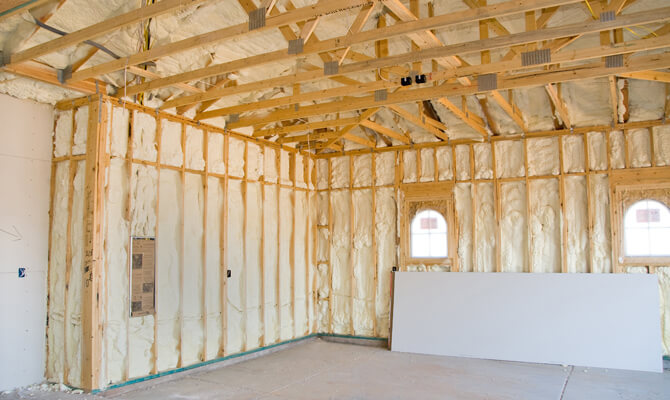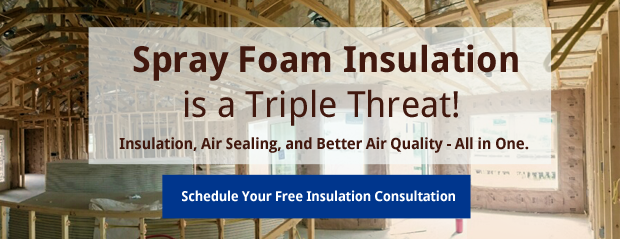
Tampa residents may not have to insulate against freezing winters, but keeping homes warm in the winter and cool in the summer require proper insulation, too. Here’s what you need to know about insulation requirements in Florida.
Insulation Requirements in Florida
Residential requirements for insulation are divided by the location in the home. Framed wall insulation must meet or exceed R-13. For block walls, interior insulation must meet or exceed R-7.8, and exterior insulation must be R-6. Ceiling insulation must be much higher at R-30, and a raised floor must be at least R-13.
Insulating power, or R-Value, is only one factor to consider when building or improving a home to keep it comfortable. Different materials respond to weather conditions differently. For example, traditional batting insulation will lose some of its insulating ability in high winds, making air-tight seals an important consideration when using this insulation type.
Insulation Materials
Because each type of insulation responds to building and weather conditions differently, there’s more to consider beyond mandated insulation requirements if your goal is a comfortable home. Here’s a look at the different types of insulation, along with a few considerations for each.
- Batts and Rolls. This is the type of insulation that most people are familiar with. It is usually made from fiberglass but can also be made with mineral wool, plastic fibers, and natural fibers. It’s recommended for use in framed walls, floors, and ceilings because it’s easily laid between studs, joists, and beams. When choosing this type, safety precautions must be taken as the tiny fibers can be hazardous–especially if they are inhaled. It also does not provide an air-tight seal, so additional measures are necessary to prevent air leaks.
- Reflective Systems. Made from foil-covered paper, plastic, or cardboard, a reflective system is a good choice for unfinished walls, ceilings, and floors. It is most effective at preventing downward heat flow–or preventing heat from entering a structure–making it most useful in warmer climates. A reflective insulation system is not as effective at keeping warm air in and does not provide any protection from air leaks, so it may not be suitable for cooler weather.
- Rigid Foam. Made from polystyrene, polyisocyanurate, or polyurethane, this type of insulation is recommended for unfinished walls, floors, and ceilings along with unvented, low-slope roofs. It provides excellent insulation with relatively low thickness. Rigid foam is easy to cut to size and apply to large structural areas such as ceilings and walls, but can be very difficult to fit around obstacles and into tight spaces. It must also be used in conjunction with building-code approved material for fire safety when used on interior spaces. For exterior spaces, it must be covered with a weatherproof facing.
- Loose Fill. Cellulose, fiberglass, and mineral wool are common materials used for loose-fill and blown-in insulation. It is an excellent choice for adding insulation to an existing home because it can be applied without entirely removing existing walls and into other hard-to-reach places. Loose-fill requires specialized machinery, so this is not a DIY project for most homeowners. Cellulose can also become too heavy for some attics, and it’s susceptible to mold infestations when exposed to damp conditions. Also, as loose-fill compresses over time, it loses some of its effectiveness.
- Spray Foam. Typically a chemical mixture, spray foam is an excellent choice for adding insulation to existing finished areas and for reaching difficult and irregular spaces. It is easiest to apply on a new construction or a home undergoing a significant renovation, as exposed structures make a tightly sealed home more possible. Foam is resistant to water damage and mold growth, making it the right choice for humid climates and areas that are susceptible to flooding, heavy rains, and hurricanes. Spray foam insulation also requires special machinery and an experienced installer for proper application. It can be a bit more expensive than other insulation types. However, in exchange for these drawbacks, spray foam provides superior coverage. Because it seals directly to the surface it is covering, spray foam insulation reduces the need for air-sealing tasks such as caulking.
Free Consultation
Insulating your Florida home with spray foam will help lower your monthly energy bills while also keeping your home more comfortable in both hot and cool weather. To learn more about the benefits of spray foam and how it exceeds insulation requirements to provide superior comfort, schedule your free consultation with Wattson Home Solutions today.








